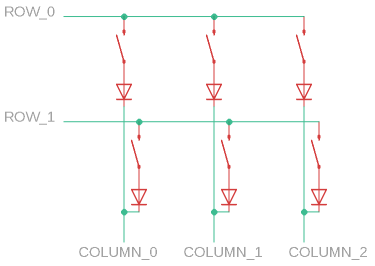# Keypad
This driver lets you read the state of any key in a keypad matrix circuit as if
it was connected to a single input pin. It supports keypads of any size, and any
embedded platform that implements the
[embedded-hal](https://crates.io/crates/embedded-hal) traits.
## Motivation
The simplest way to read keypresses with a microcontroller is to connect each
key to one input pin. However, that won't work if you have more keys than
available pins. One solution is to use a keypad matrix circuit that lets you
read from N*M keys using only N+M pins.

In this example, each row is an input pin with a pullup resistor, and each column is an open-drain output. You read the state of a particular key by driving its column pin low and reading its row pin.
A downside of this approach is that it increases code complexity. Instead of
reading a single input pin to check if a key is pressed, you need to
actively scan the matrix by driving a column low, reading a row, and setting
the column high/floating again.
The purpose of this driver is to use the `embedded-hal` traits to hide that
complexity. It does this by giving you a set of virtual `KeyInput` pins, each
of which represent one key in your keypad matrix. Because they implement the
`InputPin` trait, you can treat each one like a single input pin, without worrying about the matrix-scanning that happens under the hood.
This approach was inspired by the
[shift-register-driver](https://github.com/JoshMcguigan/shift-register-driver)
crate, which uses virtual output pins to simplify the use of a shift
register.
## Limitations
- Reading the key state is not reentrant.
- This is not optimized for scanning through the entire keypad as quickly as
possible. That's a tradeoff that comes from treating each key
as an independent input.
## Example
This example uses mock types that implement the `embeddded-hal` traits without using
any real hardware. It will compile and run on your host computer, but it
won't do anything interesting because there are no real buttons to press.
For an example that runs on an actual microcontroller, see [keypad-bluepill-example](https://github.com/e-matteson/keypad-bluepill-example).
``` rust
#![feature(nll)]
#[macro_use]
extern crate keypad;
extern crate core;
use keypad::embedded_hal::digital::InputPin;
use keypad::mock_hal::{self, GpioExt, Input, OpenDrain, Output, PullUp, GPIOA};
// Define the struct that represents your keypad matrix circuit, picking the
// row and column pin numbers.
keypad_struct!{
struct ExampleKeypad {
rows: (
mock_hal::gpioa::PA0<Input<PullUp>>,
mock_hal::gpioa::PA1<Input<PullUp>>,
mock_hal::gpioa::PA2<Input<PullUp>>,
mock_hal::gpioa::PA3<Input<PullUp>>,
),
columns: (
mock_hal::gpioa::PA4<Output<OpenDrain>>,
mock_hal::gpioa::PA5<Output<OpenDrain>>,
mock_hal::gpioa::PA6<Output<OpenDrain>>,
mock_hal::gpioa::PA7<Output<OpenDrain>>,
mock_hal::gpioa::PA8<Output<OpenDrain>>,
),
}
}
fn main() {
let pins = GPIOA::split();
// Create an instance of the keypad struct you defined above.
let keypad = keypad_new!(ExampleKeypad {
rows: (
pins.pa0.into_pull_up_input(),
pins.pa1.into_pull_up_input(),
pins.pa2.into_pull_up_input(),
pins.pa3.into_pull_up_input(),
),
columns: (
pins.pa4.into_open_drain_output(),
pins.pa5.into_open_drain_output(),
pins.pa6.into_open_drain_output(),
pins.pa7.into_open_drain_output(),
pins.pa8.into_open_drain_output(),
),
});
// Create a 2d array of virtual `KeyboardInput` pins, each representing 1 key in the
// matrix. They implement the `InputPin` trait and can (mostly) be used
// just like any other embedded-hal input pins.
let keys = keypad.decompose();
let first_key = &keys[0][0];
println!("Is first key pressed? {}\n", first_key.is_low());
// Print a table of which keys are pressed.
for (row_index, row) in keys.iter().enumerate() {
print!("row {}: ", row_index);
for key in row.iter() {
let is_pressed = if key.is_low() { 1 } else { 0 };
print!(" {} ", is_pressed);
}
println!();
}
// Give up ownership of the row and column pins.
let ((_r0, _r1, _r2, _r3), (_c0, _c1, _c2, _c3, _c4)) = keypad.release();
}
```
## License
Licensed under either of
- Apache License, Version 2.0 ([LICENSE-APACHE](LICENSE-APACHE) or
http://www.apache.org/licenses/LICENSE-2.0)
- MIT license ([LICENSE-MIT](LICENSE-MIT) or http://opensource.org/licenses/MIT)
at your option.